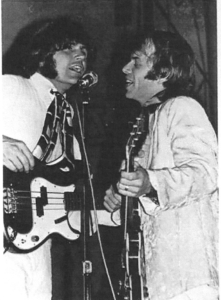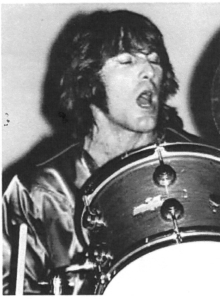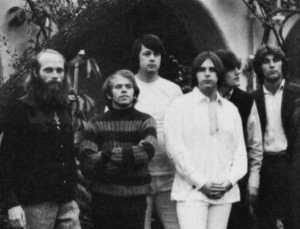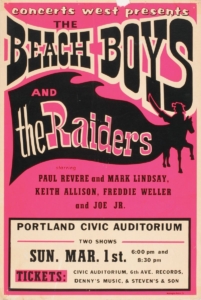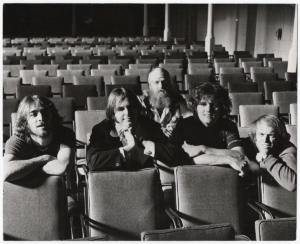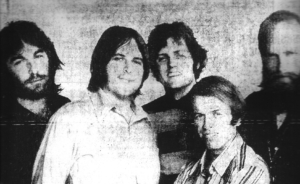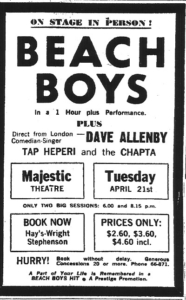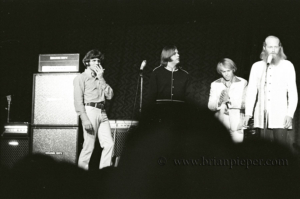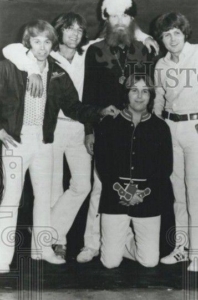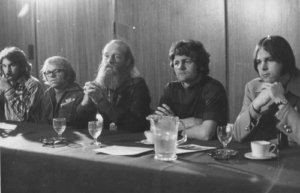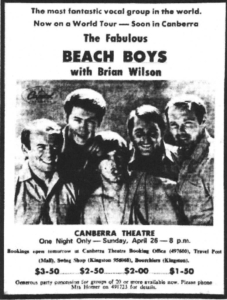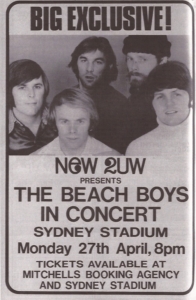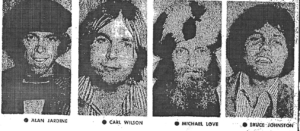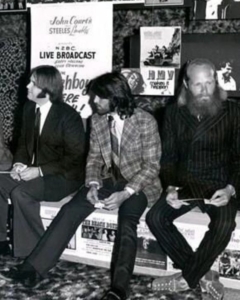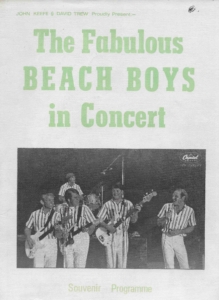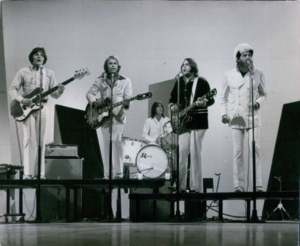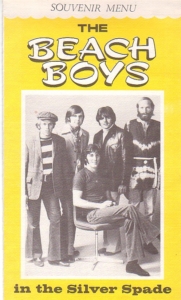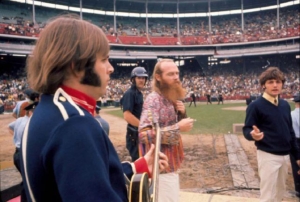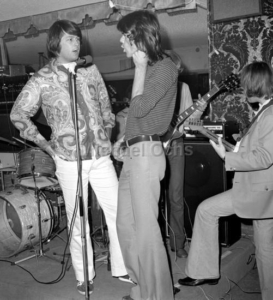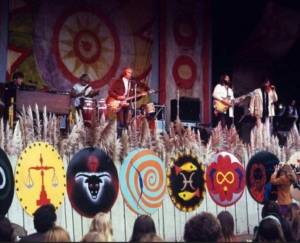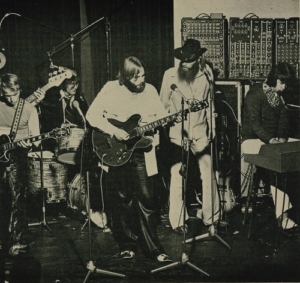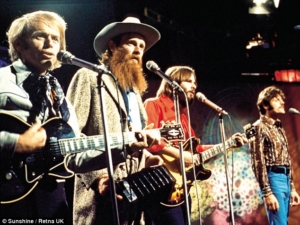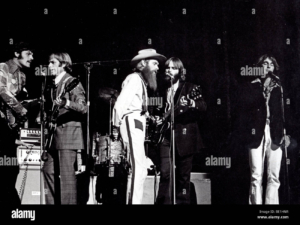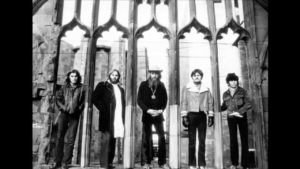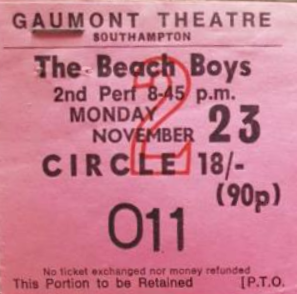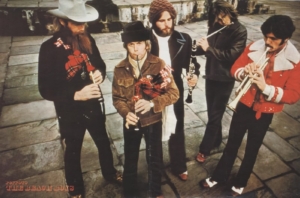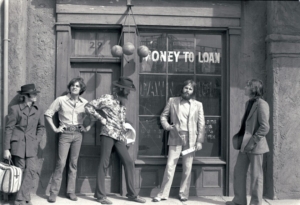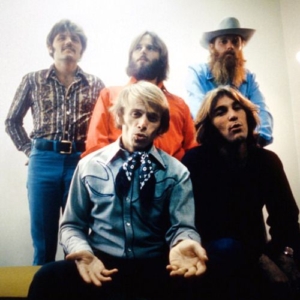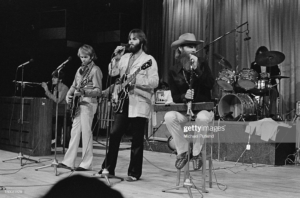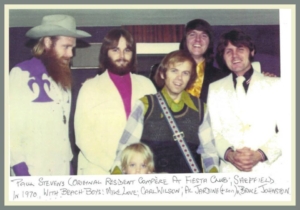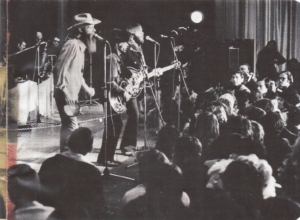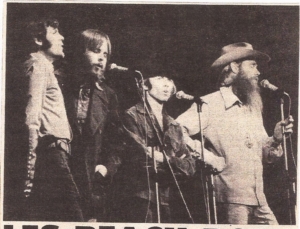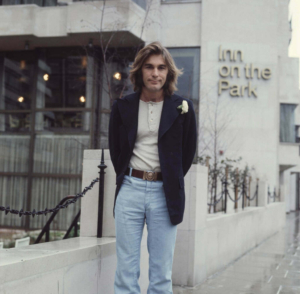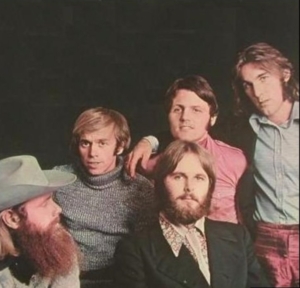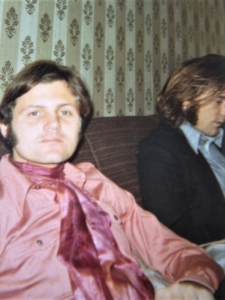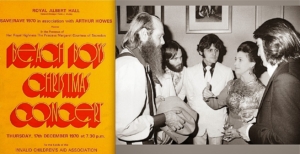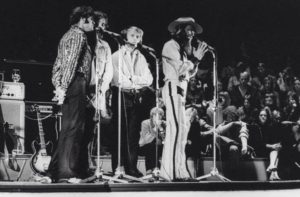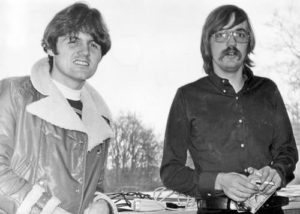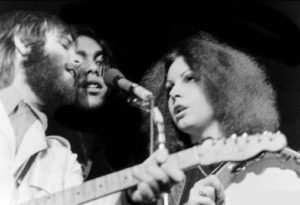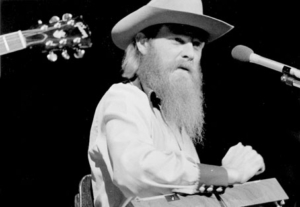Thursday February 26, 1970
Kennedy Pavilion, Gonzaga University, Spokane, WA-with Paul Revere and the Raiders
The band spent the early part of the year working on what became Sunflower, their first LP for their new label Warner Brothers. The Beach Boys were making quality product but since 1969 they had been in a commercial decline. Early signs were not encouraging. They put out ‘Add Some Music to Your Day’ as a trial single in February and it sank like a stone. Thus, early 1970 was a stressful time for the group, especially Carl. He was busy with the Beach Boys new album and also producing the first album by his protégés the Flame. However, most of Carl’s time was taken up by legal problems stemming from his failure to report for alternate service. On January 29, 1970 Carl was given three year’s probation and fined $4,000, by U.S. District Court Judge, Harry Pregerson. The judge ordered Carl to spend two of his three probation years working as an institutional helper for the County Department of Hospitals. Carl was reluctant to use his time and talents this way, so his legal battles continued until the fall of 1971. Due to these issues and the fact that all of the Beach Boys other than Bruce had young children, the Beach Boys toured very little in the U.S. in 1970.
The band was also having a hard time obtaining bookings. Then manager Fred Vail recalled, “The Beach Boys were not making big money. I had trouble putting together the Pacific Northwest tour (in Feb-Mar 1970). I had trouble putting together dates. I had promoters who had made hundreds of thousands of dollars off the Beach Boys who wouldn’t return my calls. Or they would offer me ridiculous guarantees or no guarantees. They were still a legendary act at that point and they still had a big fan base but there were so many other people involved in the music scene then. We were up against a lot of heavyweight acts of that era.” While it may have been hard to set up, ultimately the short tour of the Pacific Northwest was quite memorable. Mike Love became ill as a result of fasting too strenuously, and was hospitalized. Fred Vail recalled, “Michael basically had a melt-down.” Much to everyone’s surprise Brian agreed to fill in for him. He sang and played piano at the shows, and showed that his high falsetto voice was still intact (his increasing drug use, drinking and chain smoking would alter his voice by the late 70s). The Gonzaga Bulletin reported, “the second half of the program was presented by the Beach Boys who also blew the collective mind of the audience. They played many of their older and more familiar hits to a large conglomeration of old fans and new converts.” In a radio interview that July, Brian enthusiastically recalled “I was scared for a few minutes in the first show…it had been a while since I was in front of so many people. But after it started to cook I really got with it. It was the best three days of my life, I guess.” Brian was so enthused by the experience that he considered going on the group’s tour of Australia and New Zealand in April. He went so far as to fill out a visa application before abandoning the idea.
Friday February 27, 1970
Queen Elizabeth Theatre, Vancouver, BC, Canada-with Paul Revere and the Raiders (Two shows at 7:00 and 9:30 PM)
The photo of Dennis was taken in Gonzaga the previous night. The Beach Boys were still wearing their white suits, so I assume Brian wore one too but unfortunately no photos of Brian on this short tour have yet turned up.
Saturday February 28, 1970
Seattle Opera House, Seattle, WA-with Paul Revere and the Raiders (Two shows at 7:30 and 9:30 PM)
A low-quality audiotape of one of these two Seattle shows exists. Brian and Carl opened the show with a duel lead on “Do It Again,” Carl took the lead on “Darlin,” Brian and Al sang “Surfer Girl,” Carl sang the lead on “Sloop John B,” Al took his usual lead on “Help Me Rhonda,” Carl sang “I Can Hear Music,” Al sang the lead on “Wouldn’t It Be Nice” with Brian singing the bridge, all the Beach Boys sang “Add Some Music to Your Day” with Brian singing Mike’s parts and his own from the record, Al sang “Cotton Fields,” Carl sang “God Only Knows,” Brian took the lead on “Barbara Ann,” Bruce played a solo piano version of “Nearest Faraway Place” and Carl sang the lead on “Good Vibrations” with accompaniment by Brian.
The performance captured on tape is quite good, but reporter Jeanine Gressel of the Seattle Times was unimpressed. She argued that the Beach Boys’ problems were “entirely due to their performance. For a group that has traded on their harmonic blend, they certainly didn’t live up to past achievements in that area. The harmony was sloppy and often out of tune…True Mike Love, a regular member of the group, was absent. Love was replaced by Brian Wilson, who hadn’t been with them in performance for five years. But excuses are not allowed to professionals. Besides, the trouble didn’t seem to lie in Brian Wilson’s work at all, but was rather an overall sloppiness that seemed to infect the entire group.”
Sunday March 1, 1970
Portland Civic Auditorium, Portland, OR-with Paul Revere and the Raiders (Two shows at 6:00 and 8:30 PM)
This was the last day of the tour. Though he enjoyed the experience, Brian did not play with the group again until November, when he joined them on stage at the Whisky a Go-Go.
Saturday April 18, 1970
Town Hall, Auckland, NZ-with Dave Allenby and the Rumor (Two shows at 6:00 and 8:15 PM)
In the midst of recording Sunflower, the group took a month off to play their second tour “down under.” However, the 1970 Australian-New Zealand tour was a much more low-key affair than their first 1964 visit, no doubt due to their decline in popularity. Daryl Dragon and Ed Carter traveled with the group, along with Jon Parks, who acted as stage-manager. Steve Desper also accompanied them, though his sound system remained in California. He told a reporter from The Australian that if they had brought the system it would have cost them $180,000 to ship and re-assemble it.
The Beach Boys arrived in Auckland on April 17 to begin a four-city tour of New Zealand with opening act, British comedian, Dave Allenby. The band was delayed at the airport because Carl was missing a smallpox vaccination form and had to receive a shot from an airport physician before he could be admitted into the country.
Monday April 20, 1970
Town Hall, Wellington, NZ-with Dave Allenby (Two shows at 6:00 and 8:15 PM)
The Beach Boys played to two full houses. The Wellington Evening Post reported “Confetti and streamers fell on the group as Al Jardine, rhythm guitar, led the vocal into ‘Help Me Rhonda’ followed by Carl Wilson in ‘God Only Knows.’ Even without studio recording techniques, they produced enough effect with their smash hit ‘Good Vibrations’ to set the Town Hall rocking when fans saw the group reproduce their unique harmonizing…Mike Love…despite a somewhat marked difference in appearance from the early days of the group, sang ‘California Girls’ in true Beach Boys style…Even though the surfing sound in pop music which the Beach Boys pioneered may have become faded, the groups’ earlier hits received great response from a hard to stir Wellington audience.”
Tuesday April 21, 1970
Majestic Theatre, Christchurch, NZ-with Dave Allenby and Tap Heperi and the Chaptah (Two shows at 6:00 and 8:15 PM)
The Christchurch Press reported, “The Beach Boys concert last evening at the Majestic Theatre was a knock-out… Their playing was superb. The number ‘Good Vibrations,’ the groups biggest selling single, was probably the highlight of the performance. The presentation of this was flawless and showed how far the boys have come since their first surfing music… Some of their earlier rock numbers-such as ‘Barbara Ann,’ ‘California Girls,’ and ‘Help Me Rhonda’-were pounded at full volume in the last bracket or so, and almost brought the house to its feet.” Following these shows, the group was scheduled to play two shows in Dunedin, NZ on April 22, but the Otago Daily Times announced the group had canceled the engagement, possibly due to poor ticket sales.
Thursday April 23, 1970
Festival Hall, Melbourne, VIC, Australia-with Dave Allenby
The Beach Boys flew to Australia on Wednesday night, landing in Melbourne around midnight. Despite their exhaustion from the flight, the entire group, except Bruce, stayed up until 4 AM talking with reporter Jean Gollan. Asked about Brian’s absence, Carl replied “Well he did join us for a weekend in the states recently…and he said that he might join us in Europe but you can never tell with Brian…He just doesn’t like to travel…he didn’t like anything about touring, and he didn’t like being away from his home environment, which consists of a piano and fridge and peanut butter and wild honey and a couple of masseurs and a constant temperature above 75 degrees.” Asked about recent musical changes, Dennis said, “The music we do now is just for fun.” Carl added, “In a way we had to catch up with Brian. We’ve been developing rapidly as a group and as individuals in the last year. I guess we’ve gone into another whole cycle. We’re much stronger, independently stronger. I’m a much better singer now than I used to be. But we aren’t looking for any direction, just to have fun and be as good as we can.”
Friday April 24, 1970
Perry Lakes Stadium, Perth, WA, Australia-with Dave Allenby (8:00 PM Show)
The group flew to Perth on Friday. Dennis spent the day looking for land to buy in the area. Referring to his future wife Barbara, he told Norman Aisbett of the West Australian, “There’s a girl back home with whom I’ve a good relationship. I think we might have a small place here-just a few acres to grow a little food.” When asked why a Rockstar would leave Hollywood for Perth, he replied “Smog, I’ve just got to get away from it. It’s terrible in Los Angeles, truthfully terrible. America as a whole is at a disastrous stage with smog now. In Los Angeles there are children with weak lungs who are not allowed out of their homes…(Also) Beverly Hills people are the worst people on the earth. Their whole existence is monetary based. They calibrate greatness by wealth. If you don’t wear the cool pants, you’re out.” About 3,500 fans attended the concert that night at the outdoor Perry Lakes Stadium.
Saturday April 25, 1970
Apollo Stadium, Adelaide, SA, Australia-with Dave Allenby and the Incase (8:00 PM Show)
The group’s rented sound system was lost in transit and this concert was delayed while the crew struggled to set up a hastily compiled substitute. Over 4,000 fans waited patiently. Harold Tidemann of the Adelaide Advertiser wrote “despite sound distortion, microphone feedback and cramped conditions, there was no denying the group’s talent when they got going. Much of their appeal lay in their easy manner, the way out gear they wore and their sense of style and ensemble. Their greatest hits came towards the end, with ‘Barbara Ann,’ ‘Good Vibrations,’ and ‘Johnny B. Good.’ Teenagers went wild and screamed for more, but the boys said goodbye after about an hour on stage.”
Sunday April 26, 1970
Canberra Theatre, Canberra, ACT, Australia-with Dave Allenby (Two shows at 5:00 and 8:00 PM)
The ads for this tour, deceptively, not only featured Brian but even stated that he would be with them. Daryl Dragon recalled this tour with fondness. “It was lot of fun in Australia. I liked it because I got to hang out with Dennis Wilson a lot.”
Monday April 27, 1970
Sydney Stadium, Sydney, NSW, Australia-with Dave Allenby and Catch 22 (8:00 PM Show)
The lack of a sophisticated sound system caused problems at larger venues. Michael Symons of The Sydney Herald reported that the group’s delicate harmonies “were not exactly heard to advantage at the Stadium…All the same, Brian’s brothers Carl and Dennis, with Al Jardine, Mike Love, Bruce Johnston and two extra unnamed musicians ran through a series of two-minute hits without inflicting too much pain on the large crowd…Dressed impeccably in white, the group looked even more precious than they have sounded since leaving their original surf phase. Mike Love puffs a magnificent red beard, Carl Wilson hides his plumpness in a military jacket and his contrastingly lean, broad-shouldered brother really belted the hide out of the drums.”
Tuesday April 28, 1970
Capitol Hall, Wollongong, NSW, Australia-with Dave Allenby, Tamam Shud, Fantasy and the Turkish Green Electric Band (Two shows at 7:30 and 10:30 PM)
Surprisingly, the group allowed Murry Wilson to join them for part of this tour. However, despite his backstage request that they all wear the exact same white outfits, the Beach Boys chose to abandon their stage uniformity in favor of more casual attire. Carl wore a dark military jacket rather than his white coat, while Mike sported a blue and white Cossack hat. The group received $3600 Australian for the shows after playing to about 4,000 people.
Thursday April 30, 1970
Festival Hall, Brisbane, QLD, Australia-with Dave Allenby (8:00 PM Show)
3,853 fans attended this concert. Peter Brady of the Brisbane Courier Mail declared, “Looking nothing like the Ivy League surfers of their last Australian tour in the early 60s, the Beach Boys showed they had lost no support from Brisbane fans. The crowd clapped and cheered during the on stage antics which culminated with a ‘Happy Birthday’ sing-along for the group’s manager, and group poses for anyone who wanted to take their picture. An unaccompanied version of ‘They Had Spring in Their Hearts’ and a driving version of ‘Johnny B. Good’ also proved they had not lost any of the harmony and versatility which made them famous.”
Saturday May 2, 1970
Beachcomber Tiki Village Motel, Surfer’s Paradise, QLD, Australia-with Dave Allenby (8:00 PM Show)
This concert was filmed as part of an odd color TV special, which the group agreed to take part in for Australian Channel Seven. The show was described at the time as a “send up many of the age-old myths about Australian life” and a bicentennial celebration of Captain Cook’s landing at Botany Bay. It would be a comedic film with the Beach Boys in the role of members of Cook’s crew, who jumped ship to have a good time in town. In addition to the concert, further filming took place in Queensland and then in Sydney the following week. However, the show never aired, with the exception of a small excerpt that shows the group riding in a car dressed in pirate costumes being chased by Captain Cook (played by comedian Dave Allenby), while a live version of “I Get Around” plays. The group allegedly hated the finished product, which from the short bits I have seen would have been in the style of the Monkees’ TV show and they apparently prevented its’ release. It would be lovely to know if the concert footage survives. The photograph was taken when the BBs taped an appearance on the Tommy Leonetti TV Show on May 14, 1970 at the end of the tour.
Monday May 4 to Wednesday May 13, 1970
Silver Spade Room, Chevron-Hilton Hotel, Sydney, NSW, Australia-with Lorrae Desmond (Two shows each night)
The 1970 Australian tour culminated with a residency at a small dinner theater in the Chevron-Hilton Hotel in Sydney. The venue itself seemed representative of their decline in popularity. Unlike the giant halls they’d played in their mid-1960s heyday, the Silver Spade only held about 250 people. Fred Vail recalled, “I set up that tour. We really needed the money. I talked them into doing it. We had an offer from the Sydney (Chevron) Hilton to do a two week gig and I had to really fight with them to get them to do it. They said, ‘we don’t want to be a lounge act. We don’t want to be a Vegas act. We don’t want to be an oldies act.’ And I said, ‘you’re not. You’re still big stars in Australia. You have always been big there. This is a premiere room and they’re paying us great money.’ They were taking care of the per-diem and the rooms. I said, ‘you guys will make money if you do that gig.’ And they finally agreed to do it.”
They were scheduled to perform for five nights, but the residency was extended to nine days due to demand. The group found themselves playing to different audiences than they were used to, mostly middle-aged couples that sat at candle-lit tables surrounding the stage. Carl later recalled, “That was so bizarre, so different. We’ve never done another concert where the curtain opens and there are candles out there.” Nevertheless, the group enjoyed the experience. Bruce told journalist Roy Carr, “The Chevron is a very exclusive place. But every night without fail, the people all joined in and danced all over the floor. It proved to be really great fun for all of us.” Allegedly Australian TV filmed at least one dinner performance. A few Australian fans have told me that they recall seeing the black and white footage. Again, the fate of that footage remains unknown.
One fan that attended managed to get backstage to meet the band. He could not recall much of the encounter but had a distinct memory of being greeted at the dressing room door by Murry who said, with cigar in hand, “Come in and meet my boys!” Murry was indeed at the Chevron engagement where he gave a bombastic interview to The Australian. He told the paper “I have to give them a pep talk occasionally. Yesterday I let them have it for 40 minutes. I don’t stand any guff-none of that big star stuff washes with me. I let them know they have to work for a living just like everybody else…that’s where my boys are so good. They’re still normal…they haven’t let all this star stuff go to their heads. Plenty of people in show business are mixed up with drugs and girls, but I’ve warned them well off all that. Some people might say I meddle in the boys’ careers. But I only butt in when they ask me. I was their original manager, but I gave up after two years when the ulcers came on and my nerves were giving me hell.”
Dennis also gave an interview to Matt White of the Sydney Daily Mirror. He told him that the group had finally begun to get out of the financial hole they were in. He blamed their troubles on “our big headedness. We thought we were so great that nothing could go wrong. Then in 1967 we launched a tour of America with the Maharishi Mahesh Yogi, but nobody came and we lost half a million dollars on rented halls and air tickets. Even when we sold most of the things we had, we were still $200,000 in debt, and there were times when creditors threatened to close our office doors.” Dennis also told White about his personal life, including his plans to marry his girlfriend Barbara Charren that August. He admitted “If I’d known I would be spending $1200 in telephone calls to her in two and a half weeks I would have brought her with me. Being apart from her is terrible and I can hardly wait to meet her in Hawaii when we leave Sydney next week.”
Following the Silver Spade residency, the group remained in Sydney one extra day to tape a TV appearance and then flew to Hawaii on May 15. The tour ended up being a financial success for the group, though they almost lost the money they made due to international regulations that made it difficult for people to take large sums out of the country. Vail commented, “When they got ready to leave, they couldn’t get the money out of the country. Australia wanted to keep the money and we needed that money. That was a huge thing. I ended up having to have the venue wire the money to Arthur Howes in England, who was the Beach Boys’ agent in the U.K., and he sent the money to us. That was how we got the money out.”
Sunday June 14, 1970
Milwaukee Pop Fest, County Stadium, Milwaukee, WI-with the Supremes, Tommy Roe, John Phillips, the Jaggerz, Ides of March, Frijid Park, Frankie Avalon, Andy Kim, Edison Lighthouse, the Ventures, the Lettermen, Jack Blanchard and Misty Morgan (1:30 PM Show)
The Beach Boys were busy completing their Sunflower album but they flew to Milwaukee for an appearance at this music festival, their only concert that summer. It was sponsored by radio station WOKY. All the performers appeared for a minimum fee, so that profits could be donated to the Children’s Outing Association and the Milwaukee County Mental Health Center. In addition to the Supremes (trying to make a go of it without Diana Ross, who’d left for a solo career), the all day show, attended by 22,000 fans, featured many so-called “bubblegum” acts, like Andy Kim and Tommy Roe. As a result the concert attracted more twelve-year old girls than the Beach Boys had performed for in a while. The kids reacted enthusiastically to the group, who went on stage after 5:00 PM. Hundreds of kids left their seats and poured onto the field during “Good Vibrations” forcing the band to leave the stage for ten minutes while order was restored. During the chaos Mike Love lost a very important item. When the band returned to the stage he announced, “I have a lost and found item. Would whoever took my hat please bring it back.” However, the lucky fan that nabbed it had no intention of returning it and the newspapers reported that Mike “performed the nearly impossible task of singing ‘Good Vibrations’ with an exposed bald spot.”
The Sheboygan Journal reported, “On stage they sang their old hits, going back to the times when they sang love songs to their cars, like ‘Little Deuce Coupe,’ ‘409’ and ‘I Get Around.’ Amazingly they sang no surfing songs. And even more amazingly they sounded very good doing these old songs you tend to snicker about now. And if they did a good job on those, they did even better on ‘Sloop John B’ and ‘Good Vibrations’ and ‘Johnny B. Goode.’” A photo from this concert graced the cover of the 1971 Capitol Records compilation album Fun, Fun, Fun/Dance, Dance, Dance. As photos proves, the band had not discarded their white uniforms yet, though there were signs of rebellion. Carl wore a blue military jacket, while Mike wore his Cossack hat. By the time they played at Big Sur in October, the white outfits were gone for good.
Early July 1970
Big Gus Club, Santa Monica Blvd, Hollywood, CA
The Beach Boys made no other concert appearances in the summer, however, members of the group turned up at the now defunct Big Gus Club in West Hollywood to support their proteges The Flame, whose first LP had been produced by Carl. Billy Hinsche recalled that the event “was basically a showcase for the Flame. They opened their set with the Beatles’ ‘I’ve Got a Feeling’ and then played their own material like ‘See the Light.’” After The Flame’s performance, Carl, Brian (looking quite healthy in a paisley shirt) and Bruce took part in an impromptu jam session. Billy Hinsche, Marilyn Wilson, her sister Diane Rovell, Desi Arnaz Jr. and a young Ricci Martin also joined in. Earl Leaf of Teen Magazine captured the jam session with his camera, but what songs were played remains a mystery, as no tape or documentation survives. The exact date of this appearance is not known but Judy Sims mentioned the appearance in her column “Hollywood Scene” in the Disc & Music Echo dated July 11, 1970, so it probably happened at least a week earlier.
Saturday September 12, 1970
Lagoon, Farmington, UT (9:00 PM Show)
This was the group’s final appearance at this legendary venue. Unfortunately, no newspapers reviewed the show but undoubtedly some songs from the Sunflower album were performed along with the oldies. It would be interesting to know if Brian participated but as of now no information on this show is known. Dennis had begun work on the film Two Lane Blacktop with Monte Hellman, in which he played the role of “The Mechanic” opposite singer James Taylor and Laurie Bird and therefore probably did not play this show.
Saturday October 3, 1970
“Celebration: A Day of Music,” Big Sur Folk Festival, Monterey Fairgrounds, Monterey, CA-with Kris Kristofferson, Joan Baez, Mimi Farina, John Phillips, John Hartford, Country Joe McDonald, Mark Spoelestra, Linda Ronstadt and Merry Clayton (Two shows)
It was no longer enough for the group to record and release great music. They also needed to convince people to buy it. Jack Rieley, a charismatic radio DJ and journalist claimed that he could help them. He met the Beach Boys when Brian granted an increasingly rare radio interview to promote Sunflower. Brian, Bruce and Mike appeared on Rieley’s Radio Pacifica show on July 29, 1970. During the interview Brian commented, “The first half of our career the surf thing was projected so much. It was so clean-the sound was so clean, we looked clean, and about 1966 I think people started rejecting the image. We got a little funkier about that time, but they didn’t know it…I’m proud of the group and the name, but I think the clean American thing has hurt us. And we’re really not getting any kind of real airplay today.” After the interview, Rieley offered his services to the group. He laid out an action plan to change the Beach Boys image. He argued persuasively that they needed to ditch their matching stage uniforms and devote more time to developing their live act. The ultimate goal of Rieley’s plan involved changing the public’s perception of the group, especially the perceptions of the politically active college audiences that had rejected them. As he told the BBC in 1974, “One of the things, and we did it in a series of advertisements, was to just say it right out…It’s safe now to listen to the Beach Boys. And I remember it was a headline in one of the first ads we ran…it was sort of silly, but people were afraid to say they were into the Beach Boys.”
The seventh annual Big Sur Festival gave the group their first chance to connect with audiences that had rejected them. The group was somewhat apprehensive about playing to the hippies at Monterey. Carl Wilson commented to Robert Hilburn “I didn’t know if the audience would give us a chance. I thought they would, but you can never be sure.” Another reason for their hesitation was the fact that the concert took place while Dennis was unavailable. He had filming commitments that clashed with the festival date. Mike Kowalski replaced him on drums. The group also failed to convince Brian to join them, giving them even more trepidation. Despite their fears, the Beach Boys turned up at Big Sur and scored a knockout. Los Angeles Times critic Robert Hilburn called the appearance “Easily the best moment of the recent Big Sur Folk Festival in Monterey. The Beach Boys, a group that seemed irrevocably drowned in its own surfing image only a few months ago, were on stage playing some of the songs (both old and new) that have made them one of the handful of best and most important groups in the history of rock music.” Rolling Stone publisher Jann Wenner, who'd dismissed the group in an influential editorial in 1967, raved “the Beach Boys, quite objectively, were excellent …They were the best act there that day. Monterey Pop really did happen again because they were the one act, the one part of Monterey Pop that had yet to occur.”
The set list included a smattering of oldies but concentrated more on album cuts from recent records. The complete set list included “Wouldn’t It Be Nice,” “Sloop John B,” “Country Air,” “California Girls,” “Aren’t You Glad,” “Darlin’,” “Tears in the Morning,” “Wake the World,” “Vegetables,” “God Only Knows,” “Cottonfields,” “Their Hearts Were Full of Spring,” “Riot in Cellblock No. 9,” and “Good Vibrations.” The show was recorded and a performance of “Wouldn’t It Be Nice” was included on the concert album Celebration. The tapes are owned by Lou Adler and, as of this writing, there is no agreement to allow the full set to be officially released. A few days after the Festival, Carl and Brian granted an interview to Bill Reed of Rock magazine. Asked about the shows, Carl said, “It went fine. I only wish we’d had a little more time. There were a lot of acts so even with two sets we didn’t get a chance to play as much as we’d have liked to. I liked playing there, though.” He also commented that the band had altered their entire concept of concert performing. “We’re not so much trying to re-do the records now, although we still travel with that big sound system. We’re loosening up in our interpretations. It seems like a much more realistic thing to be doing.”
Wednesday November 4 to Saturday November 7, 1970
Whisky A-Go-Go, Los Angeles, CA-with the Flame (Two forty-five minute sets each night)
The group continued their comeback by returning to the Sunset Strip for the first time since 1962 to play a four-night stand at the popular Whisky-a-Go-Go. Mike Love saw the engagement as part of a new beginning for the group. He told Robert Hilburn, “I look at us as a whole new group starting up again. We do things now that we never did before. Much of the audience will be hearing some of the things for the first time. We’re just as much a part of the times now as we were in 1963. There’s more creativity, more maturity.” The Beach Boys engagement at the Whisky drew huge audiences, with lines of fans backed up around the block hoping to get in. Despite the small size of the club, the full band, including Daryl Dragon (keyboards), Ed Carter (bass), Mike Kowalski (percussion) and a five-piece horn section were utilized. There was one more surprise for fans. When the curtains opened on the first night, Brian Wilson was also there. The booking marked the first time all six Beach Boys were on stage at the same time for a full concert. Daryl Dragon recalled “those shows were memorable because Brian played with us. But it’s always a problem when you don’t work with one musician and out of the blue start to work with them because you have to learn their style and start to meld with them. Even though Brian wrote the music and it’s all his stuff, I wasn’t familiar with his style (of playing) so it was kind of like flying blind, waiting to see what he was going to do. He wasn’t that familiar with the band either. But the people were so blown away. It didn’t make a difference anyways.”
Judy Sims of Disc and Music Echo commented that “the Beach Boys didn’t play so long, but they covered a wide range of old and new songs. There were fifteen people on that stage…plus the, much heralded, appearance of Brian Wilson, who hadn’t performed in years. Brian looked slimmer and more handsome than the last time I saw him. He sat down at the electric piano near the Moog and didn’t really seem to do a heck of a lot. Carl still carries the group, with Mike and Al close by. Carl’s voice and guitar are the mainstays, and he handles that role with enthusiasm, something which seemed to be lacking in the others.” Elliot Tiegel of Billboard praised the Beach Boys for retaining their “characteristics: softly subtle backing voices working harmonically behind soloists: hard rhythmic patterns, strong melodies…The boys pulled ‘California Girls,’ ‘Cotton Fields,’ ‘Sloop John B,’ ‘Good Vibrations’ and ‘I Get Around’ from their flashback files. The ‘nowness’ of the band was strengthened with ‘Cool, Cool Water’ from their new LP. ‘Riot in Cellblock No. 9’ was a marvelous excursion into good funky soul patterns and some gutsy singing.”
Brian seemed to enjoy himself on opening night, singing and alternating between piano and Moog. He told a reporter afterwards, “It was good to get up there again. When I first got on stage I felt a little self-conscious. A lot of eyes were on me. So I thought okay, I’m gonna have some fun.” Unfortunately, he did not make it through the whole engagement. He returned on November 5, but left midway through the show. Mike commented, “It was during our second set that Brian started complaining about the pain in his right ear. He had to leave the stage and was taken by car straight to a specialist. He was in considerable pain.” With the exception of two brief cameos at local shows in 1971 and 1973, Brian would not play another concert until 1976. Unfortunately, no tape of the first two nights with Brian has surfaced (though Bruce suggested on a message board that he might have a soundboard recording). However, a tape of the November 6 show without Brian makes the rounds. The set-list consisted of “Darlin’,” “Aren’t You Glad,” “Wouldn’t It Be Nice,” “Wake the World,” “Cotton Fields,” “Country Air,” “Sloop John B,” “Riot In Cell Block No. 9,” “God Only Knows,” “Good Vibrations,” “It’s About Time,” “I Get Around,” and an encore of “Johnny B. Goode.” “Cool, Cool Water” and “California Girls” are not on the tape, but based on the Billboard review it’s clear that they were performed during at least one of the Whisky shows as well. The Whisky shows proved to influential Los Angelinos, who had written them off as squares, that the Beach Boys were a relevant musical force deserving of reappraisal.
Tuesday November 10, 1970
Civic Auditorium, Bakersfield, CA
This was a benefit concert on behalf of Bakersfield and Foothill High Schools. The schools had won the KAFY radio school spirit contest.
Friday November 20, 1970
Hammersmith Odeon, London, UK-with the Flame and Colin Scott (Two shows)
Another European tour was the next hurdle to clear. Carl told Eliot Tiegel of Record Mirror, “We’ll be playing in places which have beautiful facilities. We’re playing some cities in which we haven’t appeared before. We’re all really looking forward to the trip because we’ll be playing for friends and be able to do some traveling and get around.” The Beach Boys flew into London on Monday, November 16th. Brian told reporters he might accompany the group, but in the end the reclusive Beach Boy stayed home. Bruce told Lon Goddard of Record Mirror, “We never believe him when he says he’ll show up until he does, because he often changes his mind. Nice things happen when he does play with us, but people don’t ooh and aah and applaud loudly. It’s just nice.” While Brian opted out, the group brought over a large contingent of people including Steve Desper, Jack Rieley, Daryl Dragon, Ed Carter and Mike Kowalski. They also hired five British horn players. The Flame was the opening act at most of the shows.
Upon arrival in London, the group headed to the Inn on the Park Hotel to rest before holding an afternoon press conference on the “Sloop John B’ a floating discotheque on the Thames. The group’s new look attracted the press’s attention. Carl now had a full beard, which he’d grown prior to the Big Sur show and would from this point maintain as his normal look. Bruce briefly sported a moustache . The group spent their first three days in London doing promotion including an appearance on Top of the Pops (see accompanying photo) on November 18 to mime their new single “Tears in the Morning.”
The Beach Boys were initially advertised as playing their opener in Oxford on November 19 but as far as I can tell that show was canceled and the tour opened on Friday at the Hammersmith Odeon. The set list for these shows consisted of: “Cottonfields”, “Darlin”, “Wouldn’t It Be Nice”, “Country Air”, “I Can Hear Music”, “Vegetables”, “Sloop John B”, “Riot in Cell Block No 9”, “Tears in the Morning”, “God Only Knows”, “Forever”, “Good Vibrations”, “I Get Around” and “It’s About Time.” Bruce was late coming on stage and apologized to the audience. He recalled in 1989 during the “campfire” sequences of the Endless Summer TV show that he’d been at a bar with Keith Moon and raced back to the theatre where he quickly gargled with mouthwash before heading onstage. However, he soon realized to his horror that it was actually shampoo! Lon Goddard of Record Mirror enthusiastically reported, “When Mike Love pranced on stage in tight fitting, pale blue farmer suit with matching cowboy hat, it was apparent this was the top billed act. Numbers like ‘Darlin’ and “I Can Hear Music’ confirmed this…Beautifully performed versions of marvelous material proved yet again the Beach Boys are one of the foremost recording and touring groups in the world.” Andy Gray of New Musical Express gushed, “The Beach Boys have lost none of their fire when it comes to stoking up some rock & roll flames…They really attack their numbers and inject a happy sound into it…I liked Bruce’s ‘Tears in the Morning,’ the new single, and Dennis deserting his drum kit for a solo singing spot on ‘Forever.’…Great act as always.”
Ray Coleman of Melody Maker was more critical: “The Beach Boys’ panache was missing…There wasn’t any spark…If their future shows are not going to reach the standard of previous years, we will all be better off staying at home playing Pet Sounds. There is nothing sadder than a diminishing magic.” Gavin Petrie in Disc & Music Echo reserved his criticisms for Dennis, noting that when he sang “Forever,” “his lack of front line stardom showed in the way he constantly pulled up his trousers, scratched himself and generally looked like a five year old reciting for the first time at a Sunday school concert.” Dennis told writer/publicist Keith Altham a few days later, “I read that a few of the critics thought I was nervous when I performed out front during the stage act with ‘Forever’ but that wasn’t really so. I just felt humbled in front of so many people…I’d feel humble in front of an audience of two.”
Sunday November 22, 1970
Coventry Theatre, Coventry, UK-with the Flame (Two shows at 6:00 and 8:30 PM)
During the day, the BBs posed in front of the Cathedral at Coventry for a photo shoot for the German magazine Bravo. The shows that night were praised by the Coventry Telegraph: "The group shone as the Californian sun they had left behind them, brightly and unceasingly. Their flowing harmonies, their purity of sound, their pretty melodies were every bit as delightful as they are on record."
Wednesday November 25, 1970
Odeon, Birmingham, UK-with the Flame (Two shows)
While in Birmingham, Dennis gave an interview to Keith Altham for Record Mirror. Asked about his solo single “Sound of Free/Lady” which was released in the U.K. on December 4, Dennis said, “This is really what having your own record company is all about. Brother gives us the freedom to do individual things. I cut my record exactly three days before leaving for England…Frankly I prefer the B-side, ‘Lady’, which was a love song that I wrote for my wife but everyone at EMI seemed convinced that ‘Sounds of Free’ was more commercial. I intend to follow it up by next April with a solo album called ‘Poops’ or maybe ‘Hubba Bubba.’” The “Sound of Free” single was credited to Dennis Wilson and Rumbo. Daryl Dragon recalled, “That was the (toy) elephant I had when I was three years old. I had three of them, one was Rumbo, one was Dumbo and one was Chumbo. I did the string arrangements for him on that. I didn’t want credit as Daryl Dragon. I wanted Dennis to get the credit for writing it. There were people around him who said they wrote songs. They’d write one line and take a credit for writing it.” The photo was probably taken before the tour in California.
Friday November 27, 1970 to Monday November 30, 1970 and Wednesday December 2, 1970
Fiesta Club, Stockton on Tees, UK-with Keely Ford and Jimmy Marshall
The group played residencies at the Fiesta cabaret clubs in Stockton-on-Tees and Sheffield on this tour. Al explained to Richard Green, “We accepted an offer to do a cabaret week in Sydney and we had such a far-out time we decided to try and get one in England. We’re looking forward to it, but there’s only one show a night and that’s going to leave a lot of idle time. One thing we’ve never had is time.” When I wrote my book, I thought that the BBs had played only three nights in Stockton but I have since learned that they played a four-day residency. In his memoirs, the co-owner of the club, Keith Lipthorpe, recalled that he also arranged for them to double for one night at Stockton and Sheffield on Wednesday December 2nd, which involved hastily renting a coach and removing eight seats so that four tons of equipment could be loaded up. After the show everyone piled into the coach for the journey back to Sheffield and their near-midnight slot, which must have made for a tiring day. The photo was taken in Sheffield
Tuesday December 1, 1970 to Sunday December 6, 1970
Fiesta Club, Sheffield, UK-with Paul Melba and Keeley Ford
The band played one week at the Sheffield Club. A reporter from Beat Instrumental noted that Al announced on stage “Man, this is the greatest club we have ever played!” Dennis was also taken with it. He gushed that, “This place is an exception to most of the places we get asked to appear in. Even in Las Vegas we don’t get dressing rooms like these.” Dennis also commented on his larger vocal role. In addition to “Forever” and “Lady” he also performed “Barbara” (a great composition that never found a place on a Beach Boys album until a demo version was belatedly released on the 1998 Endless Harmony CD). Dennis remarked, “Put it this way, I sang more tonight than I have ever done on a Beach Boys’ show before. If you didn’t quite understand the words on the second song, don’t worry about it…I forgot them, and made some new ones up as I went along.” However, he was quick to quash rumors that he was angling for a solo career by releasing his own single. “We do have a great deal of free time…so we can do our own thing. Daryl plays with virtually any group; you name a top band and I guarantee he’ll have played with them.” Since the publication of my book, I have since learned that I made two errors: first, the Beach Boys played only six nights in Sheffield not seven, and the Flame, though listed in the program, did not participate in this engagement, as they were booked at a London club instead.
The Flame played solo dates at the Revolution Club in London on November 28, at Blaises on November 29 and then were back at Revolution for a five night residency (November 30 to December 4). They played the Marquee Club (the Rolling Stones' old stomping grounds) on December 5 and returned to Blaises for one more show on December 6.
Tuesday December 8, 1970
Gaumont Palace, Paris, France-with the Flame
This was a special benefit in support of the relatives of 142 dancers who died in a recent fire. It was filmed in color and the group’s riveting performances of “Country Air,” “Wouldn’t It Be Nice,” “Riot in Cellblock 9,” “Cotton Fields,” “Their Hearts Were Full of Spring,” and “It’s About Time” aired on the TF2 program Pop2 in April 1971. The Beach Boys, minus Bruce, were also interviewed prior to the show while lying on a large bed together. Amongst other subjects, they discussed their recent concert at Big Sur and their outdated image as a surfing group.
Friday December 11, 1970
Finsbury Park Astoria, London, UK-with the Flame (Two shows)
Mike Ledgerwood of Disc & Music Echo praised the Beach Boys performance at the Astoria but sensed dissension, noting that Mike, Dennis and Bruce seemed to be “competing against each other for the solo spotlight…. Dennis for instance did solo numbers in the second show yet appeared sadly devoid of either enthusiasm or presence out front. But he struggled defiantly through three songs when one would have been enough. Later seemingly not to be outdone, bouncy Bruce interrupted the group during ‘Tears in the Morning’ to take his solo entirely alone, except for his own piano accompaniment. I must admit it went down a storm…but if you’d seen the expressions and heard the mutterings of the others of the group as they were ordered off, it looked decidedly as though Bruce could find himself in the ‘doghouse.’”
Neil Roberts of Melody Maker declared the group “great” and noted that they “belted out their songs almost record perfect, swapping instruments after each song like a family of brothers getting dressed with not quite enough clothes to go round.” However, he argued the show would have been better if “they had scrapped some of the weaker material, like the cod rock and roll number, and one or two other less typical songs, and performed more of the standards that have made them.” Roberts’ review was illustrative of a problem that would confront the group throughout the next few years. At the same time, they were trying to get away from their archaic surfer image, many fans just wanted oldies. Bruce commented to Georgina Mells, “What brings me down more than anything is when people review our shows and only want to know about the old songs, the old surfing type things we used to do. Now we play half old stuff and half the kind of music that’s on our new LP Sunflower, and even the old things are new-old, nothing before ’66.”
Sunday December 13, 1970
Empire, Liverpool, UK-with the Flame (Two shows)
This was the last scheduled date of the UK tour. Bruce told Georgina Mells the tour was “great, really lovely…I think we all feel really happy when we’re in England. The audiences are very good here and it seems like a good place to be. I love it and it’s more than possible that next year we may settle here, find a place in London, or the country nearby and build a studio for recording using Britain as a base for Europe.” The photo was taken at the hotel that day.
Following these shows, the group concentrated on promotion. They taped an appearance for Radio Luxembourg on the 14th and Bruce Johnston was in Amsterdam on the 15th to perform a solo version of “Tears in the Morning” on the Dutch TV show Top Pop. He sang a live vocal over the pre-recorded track. The group also appeared on Belgian TV on the 16th before heading back to the U.K. for a special charity show.
Thursday December 17, 1970
“Save Rave,” Christmas Concert, Royal Albert Hall, London, UK-with the Flame, Magna Carta and the Flirtations (7:30 PM Show)
This was a benefit concert on behalf of the Invalid Children’s Aid Association. When asked why they performed so many charity events, Al replied “Man we made it, we got money. We’re all healthy (well sort of), so it just seems right that we should do something for others, it makes me feel good. The bad thing is that once you say you like charities, hundreds of letters come pouring in, asking us to play for free, or to give bread.” For the “Save-Rave” event, Bruce convinced promoter Arthur Howes to supply a small string section for “God Only Knows.” Bruce was excited about the show, which was attended by the Queen’s sister. He later told a reporter that “the best part of the whole trip was when we did the Royal Albert Hall concert and I got introduced to Princess Margaret. It’s the first time I’ve ever met a real Princess and she was a really nice lady and very polite to me.”
Friday December 18, 1970
Concertgebouw, Amsterdam, Netherlands-with the Flame (12:30 AM Show)
With the U.K. tour over the group prepared to leave England to play the remaining continental dates. They had shows scheduled in the Netherlands and Belgium and had made tentative plans to play in Yugoslavia (Dec 23-24), Germany (Christmas Day), Scandinavia (December 26-27 and 29-31) Rome (December 28) and Montreux, France (January 2). None of these concerts took place. One reason for the cancelations was that Carl suffered an attack of appendicitis and was playing the tour in tremendous pain. Bruce gave an interview on Friday morning to Georgina Mells for Fabulous 208 and told her that Carl ‘s health was “not too bad really although he has been in pain for quite awhile, but I know how it is with an appendix because I had pains from mine for a long time before I finally had it out. I think when you’re under stress it makes it worse. Anyway, unless we miss our date in Amsterdam tonight because of the fog and have to play it later, we should be going home in a few days and he can rest and get well at home in the States.”
The Amsterdam show performed that night has since taken on legendary status. It didn’t start until 4:00 AM because the Beach Boys were delayed in London by fog, but the promoter refused to cancel. As Jack Rieley later explained to Rob Bartlett of Beat Instrumental, “By six o’clock that evening we had virtually given up, but the promoter had hired a jet from Gatwick for us, so we drove down there, boarded the plane and made Brussels by 10 PM. There were twelve limousines waiting for us when we arrived and after the drive to Amsterdam the Beach Boys finally went on stage at 5:30 in the morning…to a completely packed house, not an empty seat in the place. It was incredible and we decided there and then that there was something ‘strange’ about the place!”
Saturday December 19, 1970
De Doelen, Rotterdam, Netherlands-with the Flame (12:15 PM Show)
Radio Caroline taped this show and a portion of it was aired. At the beginning of the broadcast, Bruce announced “Very nice to be here. Tonight we’re not late…last night…eh…we brought some English fog with us and that made us very late, but anyway here we are,” and the band launched into show opener “Cotton Fields.” The group then performed “Country Air,” “Aren’t You Glad,” “Vegetables,” and “Tears in the Morning” before the broadcast ended. The photo of Bruce was taken on December 15.
Sunday December 20, 1970
Congresgebouw, The Hague, Netherlands-with the Flame (8:30 PM Show)
The Beach Boys sold out the Congresgebouw. The Leidsche Courant reported, “The best [songs] were the old hits ‘God Only Knows,’ ‘Sloop John B,’ and ‘Good Vibrations,’ the a cappella ‘Full Of Spring’ (in this song one could really hear that the Beach Boys are blessed with great voices), and ‘Tears In The Morning,’ a song from their new album Sunflower, now marvelously sung solo by Bruce Johnston. Less impressive was the solo performance of drummer Dennis Wilson who by performing two songs gave a foretaste of his soon to appear solo album that will be released by the Beach Boys own label. But in all it was really enjoyable, with the perfect close harmony of the American Beach Boys, receiving very loud cheers from the massive audience.”

